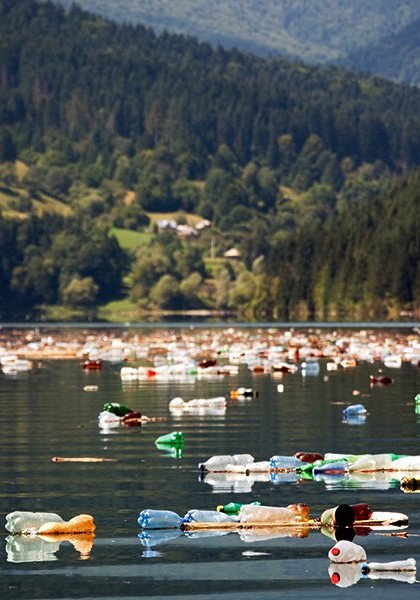Three simple ways students can help limit their carbon footprint

National parks have taken initiative by ending the sale of plastic water bottles to help combat pollution.
The student section at high school football games is the craziest section in the stands. They show support for their team while covered head-to-toe in outfits influenced by the themes, and they lose their sanity over touchdowns and unfair calls.
The student section has one important job: to show their pride and support for FHC. Meanwhile, the cheer team on the track has been dodging the flying Skittles, bottle caps, and other concession food being thrown by some students.
We—the cheer team—are showing our support and pride too, but in return, we have to pick up the wasteful mess being unrightfully thrown at us. The game of “throwing trash at cheerleaders” for jokes and giggles has gotten out of hand. After the fourth quarter ends, I help pick up the litter students have carelessly thrown at us. Once, in my hand alone, there were thirteen bottle caps and a pile of purple Skittles.
The “fun” game of throwing litter at girls on the track is disgusting; one of the many problems with this is that students are comfortable with throwing their trash wherever they feel like it. This raises the question: do students know the environmental repercussions of being careless?
The students who recognize the repercussions know that the number one cause of global warming and habitat loss is waste. On the other hand, the students who don’t acknowledge it continue to throw Skittles and bottle caps from the bleachers.
The fossil fuels burned when we drive from point A to point B are waste. The recyclable aluminum cans we throw in the trash are waste. The Ziploc bags we use to hold snacks and sandwiches are waste. It’s all unnecessary waste with better eco-friendly alternatives, and as high school students, we need to watch out for our planet—our home for the decades to come.
Reusable water bottles
Prices for cases of bottled water can range from $3-$5, and individual bottles sold at concession stands can be upwards of $1.50. The plastic water bottles themselves are recyclable, but the plastic that encases them is not. The bottles are for single-use anyway, and it is not a given that everyone will find the nearest recycling bin to properly dispose of their waste. At FHC, we are fortunate to have refillable water bottle stations readily available on campus. Using a reusable water bottle at school, sports practice, or home ensures that people aren’t contributing to harmful statistics; an estimated 250 billion water bottles end up in the ocean each year, and it’s believed that the real number could be even higher.
Animals are not accustomed to seeing floating plastic on top of the water in which they live. Because of this new phenomenon, they mistake the bottles for predators and the caps/rings for food, possibly resulting in death. Eight to nine metric tons of plastic end up in oceans across the globe each year, and a disturbing fraction of that ends up in the digestive systems of ocean life.
Transportation: electric/hybrid cars, bikes, and public transportation
As teens, most of us are nearing two major milestones: age 16 and a driver’s license. Picking out the perfect car can be hard as there are many factors to consider, such as the color, price, model, and dependability. But another factor to consider should be whether or not it’s electric or hybrid. Electric cars require a charge for them to work, and hybrid cars operate on either a battery or fuel. Electric cars are known to be a little more expensive, but in the long run, they’ll help save the remaining hope for our dying planet. As for hybrid cars, it doesn’t completely eliminate the option of gas. Yes, burning fossil fuels and CO2 emissions are the leading cause of global warming, but hybrid cars are better than driving a car that’s solely dependent on gas.
However, electric and hybrid cars can be expensive and therefore not accessible to everyone. Fortunately, Grand Rapids boasts a significant amount of sidewalks and bike lanes. Skateboarding, biking, and walking are forms of transportation that require no gas whatsoever, and they also promote healthy habits. If a destination is simply too far away to walk, taking the bus is also a good option. It might not be the best option, but it reduces the rate of fossil fuels burned.
Upcycling old clothing or buying from second-hand stores
The vast majority of my wardrobe is clothes that I have altered in one way or another. I have a habit of buying clothes that look like they’ll fit me, but once I rip the tags off and try them on, they don’t fit how I initially envisioned. I’ve cut all my jeans to a desirable length, and I’ve sewn the waist to make them fit better. I’ve even gone as far as cutting out an old button fly and replacing it with a piece of repurposed ribbon. I’ve done similar alterations on my shirts, shorts, and even sweatshirts, and in the end, I’ve turned a “useless” piece of clothing into a go-to article of clothing.
Sometimes, some pieces of clothing can’t be saved, and all attempts to resurrect them fail. Instead of throwing the clothes out, donating them to a friend, family member, or to stores such as Goodwill, The Salvation Army, or Plato’s Closet are eco-friendly options. Buying clothing second-hand or thrifting gives the clothes another run at life in somebody else’s closet, rather than contributing to the mass of textiles polluting bodies of water.
The availability of eco-friendly alternatives for practices that are harmful to animals and the environment continues to increase. Before you pump gas into your car or throw only the purple Skittles at cheerleaders, think about how this will affect our earth’s environment for years to come.

For a third round, Sydney returns to write for The Central Trend as a junior. During the summer, she attended the Washington Journalism and Media Conference...
























































































